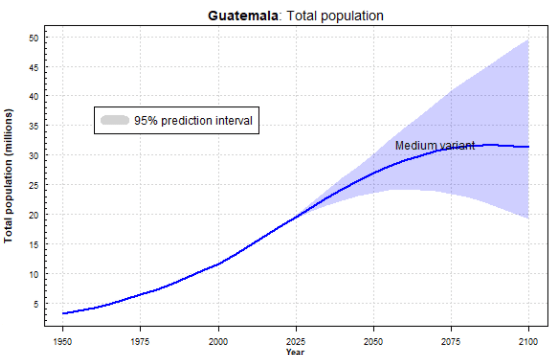Climate Refugees or Overpopulation Refugees?
The focus on climate change belies the catastrophic impacts of population growth and lack of opportunity underlying migration from Central America and Mexico.

Guatemala Population, 1950-2100. Actual data 1950-2015, projections 2015-2100 with 95% confidence intervals. Source: United Nations, DESA, Population Division, World Population Prospects 2019.
|
In an article titled Climate refugees or overpopulation escapees?, which appeared last month in The Overpopulation Project, Philip Cafaro dissects an article that was published in July by the New York Times Magazine. That article was called The Great Climate Migration and it tells compelling stories of people desperate to flee poverty, danger and environmental collapse in Central America. As implied by its title, the Times article is heavily slanted in presenting migration as a function of global climate change, but the data it presents tell a very different story.
Based on models cited by the article’s author, Abraham Lustgarden, the number of migrants who “are driven primarily by climate” constitute “as much as 5 percent of the total. If governments take modest action to reduce climate emissions, about 680,000 climate migrants might move from Central America and Mexico to the United States between now and 2050. If emissions continue unabated, leading to more extreme warming, that number jumps to more than a million people.”
In other words, failing to moderate climate emissions will, over a thirty-year period, make a difference of about 320,000 people seeking to legally enter the US from Central America and Mexico. To put that into perspective, the current Liberal government of Canada would like to increase legal immigration to Canada to 350,000 annually. The impact of climate change for the coming 30 years on Central American migration to the US amounts to about one year’s intake of immigrants to the much smaller (in terms of population) country of Canada as it strives to grow its population on the basis of thoroughly debunked economic arguments.
As Cafaro points out, regardless of action on climate change or the generosity (or stinginess) of government development assistance, migrants pour out of Central America by the tens of millions. And although the front page of the New York Times Magazine bellows an ominous warning, As Warming Makes Parts of the Planet Less and Less Livable, an Epic Climate Migration Has Begun, these people are not, in fact “climate refugees.” The underlying cause of ninety-five percent of migration has nothing to do with climate.
Overpopulation: The Overlooked Contributing Factor
The individuals profiled in Lustgarden’s article have experienced rampant crime, corrupt governments, and elites indifferent to their suffering. But Lustgarden’s article omits a major contributing factor, one that underlies or exacerbates all other problems: overpopulation. The focus of Lustgarden’s article is Guatemala, for which Cafaro provides some statistics. From 3 million in 1950, Guatemala’s population has ballooned six-fold to 18 million today and continues to grow rapidly due to a total fertility rate well above replacement. The high proportion of young people in Guatemala’s age profile, shown in Cafaro’s article, will drive its population growth for many years, even if the fertility rate were to drop instantly.
So What Gives?
Cafaro argues that at a time when the economic arguments for growth are becoming less compelling to Americans increasingly aware of the environmental and wage-depressing impacts of an endless stream of legal and illegal migrants, moral arguments for climate refugees are being advanced. The argument can be summarized as follows: fossil fuel consumption in rich countries, especially the US, drives climate change; this creates millions of refugees who are desperate because of what rich countries have done; consequently, developed countries are morally obligated to open their borders.
This alleged moral obligation for open borders gives corporations cheap labour and more consumers, while citizens who object can be dismissed as xenophobic racists. But, as Cafaro points out, not only is climate change a minor contributing factor to migration, but moving people from poor, low greenhouse gas-emitting countries to the US and other rich nations enormously increases their GHG emissions. Furthermore, the safety valve offered by migration and the remittances sent back home simply encourages business as usual and continued government malpractice in overpopulated countries with failing societies.
Brainwashed for Growth
Cafaro refers to the New York Times Magazine article as part of an expanding genre promoting growth. And indeed, here in Canada, we are constantly reminded of our alleged need for growth by the government, by the media and by corporations. The Century Initiative, which seems to be the script-writer for the government’s immigration policy, is pushing for a Canadian population of 100 million. But while Canada’s rapid growth has benefitted bankers, speculators, developers, and businesses seeking cheap labour, it hasn’t increased either the real earnings or well-being of the average Canadian.
Greenhouse gas emissions rise in concert with population growth. Expanding migration to accommodate “climate refugees” is, in Cafaro’s words, “a Ponzi scheme perpetuated by falsehoods that’s bound to end badly.”
The total fertility rates of high-consuming, high GHG-emitting industrialized countries have fallen dramatically; all are at or below replacement. That is a good thing. Their populations shouldn’t be driven upward through high immigration. Instead, countries that can’t provide enough jobs or adequate services for their growing populations should be encouraged to stabilize their populations by providing education, family planning programs and contraception for those who want it. And those countries that strive to do so should be rewarded with developmental assistance to reach that goal.
We invite you to engage with us on Facebook, Twitter or LinkedIn, where we aim to educate and inform others about the consequences of overpopulation. We’d be glad to have you join the conversation.
ABOUT THE AUTHOR
Madeline Weld, Ph.D., is the President of Population Institute Canada. Retired from Health Canada, she is a Director of Canadian Humanist Publications and an editor of the quarterly magazine it publishes, Humanist Perspectives.
|